Ta Mok’s Brother-In-Law Testifies on Deportation of Khmer Krom
Yesterday’s witness – In Yoeun – who was scheduled to testify today, could not do so because of health reasons. Witness San Lorn (2-TCW-1007) was heard instead. The district messenger and brother-in-law of Ta Mok testified on the transportation of people that might have been Khmer Krom from different communes to Tram Kok. He also talked about orders that stemmed from Ta Mok.
Functions of San Lorn
At the beginning of the session, the Trial Chamber Greffier confirmed the presence of all parties with Nuon Chea following the proceedings from the holding cell as usual. Witness In Yoeun was not able to testify today, because of a “health emergency”. Witness 2-TCW-1007 would be heard instead.
Witness San Lorn, 73, was born in Prah Keab Village, Tram Kok District, Takeo Province. He lives Sre Chrey Village in Chhak Roka commune, Samlaut. After informing the witness about his rights and obligations, the floor was granted to Nuon Chea Defense Team. Mr. Victor Koppe said that they had requested this witness to be called in relation to Tram Kok District, and not in relation to the treatment of the Vietnamese. He requested to be able to cross-examine this witness after the questioning by the Co-Prosecution. International Senior Assistant Prosecutor Dale Lysak said that they had no objection to extra time being granted to the Defense Team.
Mr. Koppe asked whether it was correct that he spent all his time in Tram Kok District until 1975, which the witness confirmed. He could not recall spending time in Takeo Provincial Town.
Mr. Koppe asked whether it was correct that he had family connections to Ta Mok. He confirmed this and said that he was the younger brother-in-law of Ta Mok. Ta Mok’s wife was his elder sister. He knew Ta Mok, since he “was pretty young.”
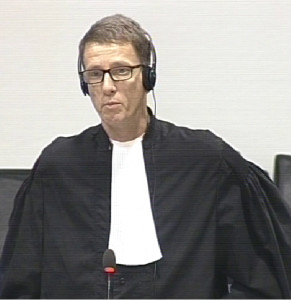
International Nuon Chea Defense Counsel Victor Koppe
He had referred to Ta Mok as “the supreme leader”.[1] Mr. Koppe wanted to know whether it was correct that he had said this. Mr. Lorn explained that the highest leader was Pol Pot, while Ta Mok came second in line. To his knowledge, he was also known was Ta 15.
Mr. Koppe asked whether he held any positions between 1975 and 1979 in Tram Kok District. He denied this. He was a messenger at the commune level and for the district committee. Mr. Koppe wanted to know whether he was a messenger for someone called Ta Chim and Pech Chim, which he denied. He was the messenger for Yeay Khom, he said. She was the daughter of Ta Mok. He remembered that Ta Chim was also in the district committee.
Mr. Koppe wanted to know whether he was a secretary in Prah Keab. He said that he was the village chief of Trak Keab in 1971. He was the messenger of Yeay Khom in 1974 or 1975. He said that he was in Battambang to study agriculture in 1976. Mr. Koppe asked whether he was sure it was 1976 and not 1977 or 1978. He replied that he was not sure. Mr. Koppe then inquired whether he was in Battambang when “the Vietnamese troops invaded Kampuchea.” He answered that they fled the school at the time.
Massacres and Deportations of Vietnamese
He also transported people. He did so upon instruction by the district. He did not understand at the time the type of people he transported. Neither did he know their names nor did he hear them speak. The transportation of people lasted four days. It took place at the beginning of 1975.
Mr. Koppe inquired whether he had ever been in Takeo Provincial Town either in 1975 or during the time of the Lon Nol regime. He said that he did not live there. “I lived in the rural area.” Mr. Koppe asked whether he knew someone called Ul Hoeun, which the witness denied. Mr. Koppe said that Ul Hoeun knew the witness. Mr. Sorn insisted that he did not know him.
Mr. Koppe said that Ul Hoeun had testified that Vietnamese people were killed by the Lon Nol regime by putting into the Dai Pram School and then firing on them in Takeo Provincial Town,[2] but Mr. Lorn denied having heard about this. Neither had he heard of mass killings of Vietnamese during the Lon Nol regime.
Mr. Koppe read out an excerpt of the book by Elizabeth Becker.[3] She had talked about massacres of Vietnamese people during the Lon Nol regime that gained international attention. Mr. Koppe asked whether he could not remember such a massacre. The witness said that he could not recall it.
Mr. Koppe turned to another event of 1973 and asked whether he had heard of clashes between Viet Cong forces and forces led by Ta Mok. Mr. Lorn said that he had not heard about this either. He had heard from other people that there were Vietnamese troops entering Cambodia. Mr. Koppe inquired whether he was able to estimate how many people of Vietnamese ethnicity were living in his province as of April 1975. He said that he did not know. Mr. Koppe pressed on and asked whether there were a lot or only a few. He said that “a huge number of Vietnamese people were gathered and deported back to Vietnam.” He could not recall when exactly this took place, but it was after 1975. Mr. Koppe inquired whether he was involved in the transport of these people himself. Mr. Lorn said that he was not. He had heard that this was a deportation from other people.
Treatment of Lon Nol soldiers
Mr. Koppe asked whether someone called Ek Hoeun meant anything to him, which the witness denied. Mr. Koppe said that Hoeun had told the court that Mr. Lorn was involved in the transportation of about 9,000 Vietnamese. He recounted that the district gave the order to transport these people. He confirmed that this took place in the beginning of the regime. Mr. Koppe wanted to know what he knew about the treatment of former Lon Nol officials in Takeo Province or even in the whole Southwest Zone.
Mr. Koppe asked whether he heard Ta Mok or Ta Saom speak about what should be done to Lon Nol officials from the rank of second lieutenant up to colonel. He said that he did not know about this. Mr. Koppe then asked whether he heard instructions given by the sector that Lon Nol officials up to colonel “were not to be harmed.” The witness said that he did not know anything about this, because it was not in the description of the tasks assigned to him.
Mr. Koppe then wanted to know whether he was ever in a position to read the letters that he delivered from the districts to the communes, which he denied. Mr. Koppe said that he wanted to reserve the five to ten minutes that he had left for possible cross-examination at the end of the day.
Background of the witness
The floor was then granted to Senior Assistant Prosecutor Dale Lysak. He started his line of questioning by asking about his age. He asked whether he was born around 1943, which he confirmed. Mr. Lysak asked whether he was sure that he was born in the year of the monkey, which the witness confirmed. Mr. Lysak said that he had repeatedly stressed in his interview that he did not understand what was happening during the Khmer Rouge, since he was young at the time. Mr. Lysak said that if he was born during the year that he said he was, he was around 31 years old when the Khmer Rouge took power, which meant that he was not a “young boy” as he had said in the interview. The witness confirmed this.
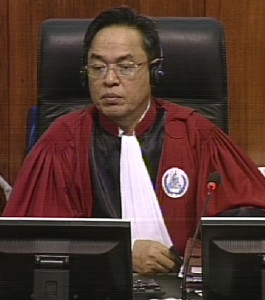
Trial Chamber President Nil Nonn
Mr. Lysak pointed out that he had said in his first part of the interview that he had never met Ta Mok during the Khmer Rouge, a fact he later acknowledged. Moreover, he had said that he “did nothing” during the Khmer Rouge while later acknowledging his role. Mr. Lysak asked why he had said this. The witness replied that “the thing is, in the beginning I could not recall what had happened – I could not recall those events. And later on, I recalled about these events of me knowing Ta Mok.” Mr. Lysak asked whether there were events that had happened
during the Khmer Rouge that he was afraid to talk about or would rather not talk about. Mr. Lorn replied that “it is difficult to say anything during the Khmer Rouge regime. I was afraid of saying anything at the time. I was afraid of being accused.” He said that he was afraid that “what he said” would “go to the attention” of the leaders. “I was afraid that my words would carry negative impacts.” He clarified that he referred to the Khmer Rouge regime. At this point, the President Nil Nonn adjourned the hearing for a break.
Tasks and timing
After the first break, Mr. Lysak continued his line of questioning. He sought more detail about the tasks that Mr. Lorn had and the timing of these. He inquired whether he was still working as a messenger for the district level when Yeay Khom left and Ta Chim became district chief. He confirmed that he remained working as a messenger.
Mr. Lysak pointed out that Mr. Lorn had said that he was a messenger about Ta Chim.[4] Mr. Lysak asked whether this meant that he initially worked for Yeay Khom and then worked for Ta Chim afterwards. He confirmed this. He received order both from the district and other offices. He was in Tram Kok in 1975. “At that time, Ta Mok sent an order to the lower level cadre. The lower-level cadre sent him to Battambang to study agriculture.
Mr. Lysak referred to his Written Record of Interview, in which he had said that he studied in Battambang for a year before the Vietnamese arrived in Cambodia.[5] Mr. Lorn confirmed this. Mr. Lysak asked whether it was possible that it was in late 1978 that he went to Battambang and not earlier, which the witness confirmed.
Figures of authority
Mr. Lysak turned to the next topic and asked whether he remembered who the district chief was during the time that he was ordered to transport people for four days. Mr. Lorn replied that the order came from the district office. Yeay Khom was the district chief at the time.
Mr. Lysak referred to an excerpt of his interview, where he had corrected himself and said that Pech Chim was the district chief at the time.[6] Mr. Lorn answered that he was instructed to transport people from the person named Phy at the office. He did not know whether the person received the order received the order from Khom or Chim. Phy worked at the district office and was in charge of people’s affairs.
Mr. Lysak read out answer 463, in which he had said that Phy was responsible for education office. Mr. Lorn confirmed this. The office was “far away from the district office”. Phy’s office was located in Samraong. The office where he worked as a district messenger was located in Ang Roka. Mr. Lysak explained that there were two offices in the area: one was located at the border of Samraong and Kus Commune and was referred to as Kraing Ta Chan, while the other was located in Ang Rokha. Mr. Lysak wanted to know whether Phy was responsible for both or for one of the office. Mr. Lorn replied that Phy was in overall charge. He was subordinate to the district secretary.
Mr. Lysak wanted to know whether he knew a person called Meng who was located at an education office. Mr. Lorn said that he did not know this person. Neither did he know someone called Dorn. Mr. Lysak asked whether he could not remember a period where Dorn took over from Phy, which the witness could not.
Mr. Lysak backtracked to the issue of timing of the four-day transport. Mr. Lysak wanted to know when this took place in relation to the deportation of Vietnamese that he had heard of. He said that he could not remember when this took place, but “I indeed went to transport the Vietnamese under the orders of Phy.” This happened “almost close to the day that you described.” He transported them to Tram Kok. He said that he transported them to the village of Nhaeng Nhang. There was no visible office where he transported them to.
Mr. Lysak pointed out that he had indicated that he brought them to Tram Kok.[7] He said that he brought them to Nhaeng Nhang commune. Upon his arrival, the district chief of militia, for example in Sre Ronoung, came to receive these people. He could not remember his name. He transported the people with “a huge truck.” He transported people from various communes. The commune chiefs in each commune were responsible for gathering the people.
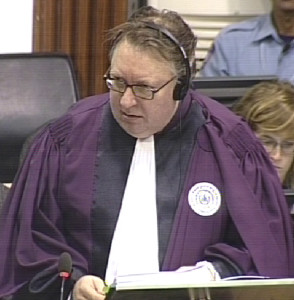
International Senior Assistant Prosecutor Dale Lysak
Mr. Lysak inquired whether he was able to transport all the people who had been gathered in one trip or whether he had to make multiple trips to transport all the people. The witness could not recall this. The truck could load 50 or 60 people at once.
Turning to Ta Mok, Mr. Lysak wanted to know whether Ta Mok came to Tram Kok and held meetings there. Mr. Lorn answered that he came to the district office. “He was there for a brief moment, after which he returned back to his office.” He came to see the district chief once to discuss something with him, but he did not know the content of the discussion.
Mr. Lysak said that Mr. Lorn had identified another relative of his, Ta Thit, as being the sector secretary at some point. Mr. Lysak wanted to know whether he came to his district office. Mr. Lorn replied that Ta Thit went from district to district. Mr. Lysak then wanted to know whether he remembered the person called Saom who took over the sector secretary after Ta Thit. He used to come to the district office.
Mr. Lysak asked whether Ta Mok and Ta Saom came to the district office at the same time. The witness replied that he did not understand why the person came to the district office.
Mr. Lysak referred back to the interview, in which he had said that Ta Thit came to the district office and met Ta Mok there.[8] Mr. Lysak wanted to know whether Ta Mok and Ta Thit met with Pech Chim or Yeay Khom. He confirmed the statement that Mr. Lysak read out, which indicated that the leading cadres met with Pech Chim.
He could not recall whether he received the assignment to transport people before or after they met.
In answers 919-920, he had said that he received the assignment to transport the people after they met around three times. He agreed with this statement now. The messenger of Ta Mok delivered orders to the district. The messenger was Tuch, who communicated the orders.
Deportation of Khmer Krom people
After the lunch break, the Chamber gave the floor back to the Co-Prosecutors. Mr. Lysak turned to the topic of arrests ordered by Ta Mok.[9] He wanted to know how he knew that the district received orders from Ta Mok to arrest persons. Mr. Lorn had said in his interview that he knew about the arrests when working at the district. He said that he knew that they were ordered by Ta Mok. He said that the messenger Tuy sometimes come by himself to deliver the orders.
Mr. Lysak said that Mr. Lorn was read an excerpt of Ek Hoeun’s testimony during his interview, which seemed to have triggered his interview.[10] Mr. Lysak asked why he remembered the incident of transporting people for four days that Hoeun had mentioned. He replied that he had told the court about this issue already.
Mr. Lysak wanted to know whether he remembered a person named Yorn, which the witness denied. Mr. Lysak further asked how many people from the district militia were there to receive the people he transported. He replied that there militia chiefs were there. “They were with their group, a group of ten, for instance.”
Mr. Lysak requested leave to present a report from Ang Ta Saom Commune from 26 April 1977 regarding Vietnamese and Khmer Krom people.[11] The request was granted. A reference was made to a militia chief called Comrade Yorn. Mr. Lysak asked whether this refreshed his memory. Mr. Lorn said that he could not recall it.
Mr. Lysak referred to several lists from different communes that indicated that transport of Khmer Krom families (Ang Ta Saom Commune, 30 April 1977; Purpol commune: 64 families; Kus Commune, 29 April 1977: 35 families; Srey Ronong Commung, 27 April 1977: 37 families).[12]
Mr. Lysak wanted to know whether it might have been April or May 1977 that he transported people. Mr. Koppe objected and said that it was a leading question. The objection was overruled, since an open question was asked first. When Mr. Lysak repeated the question, Mr. Koppe objected again. The President said that the issue had already been ruled upon and instructed Mr. Lysak to continue. Mr. Lysak asked whether these lists helped the witness to refresh his memory when he picked up people from the commune. The witness replied that he could not recall when the transportation took place.
Mr. Lysak wanted to know whether he knew what happened to those people that he transported. He replied that he never saw those people again. Mr. Lysak wanted to know whether he knew the pagoda Wat Champa Leu. He denied having known this pagoda.
Mr. Lysak referred to another cadre’s testimony Ul Hoeun.[13]
Mr. Koppe objected and said that Ul Hoeun himself had said that he was not a cadre.[14] Mr. Lysak mentioned that the person had testified of having worked in the district office, but rephrased the question. He said that Ul Hoeun had talked about the gathering of people and Lon Nol soldiers being separated and taken away at Wat Champa Leu.
Mr. Koppe interjected and said that Mr. Lysak had not given the full side of the evidence. The objection was overruled. Mr. Lysak asked whether he could remember such an event, which the witness could not.
Mr. Lysak asked to be able to show a document relating to the treatment of Lon Nol soldiers in Tram Kok district.[15] Mr. Lysak asked whether communes were instructed to identify Lon Nol soldiers who formerly held ranks. Mr. Lorn said that he was not aware of the matter. With this, Mr. Lysak gave the floor to his national colleague.
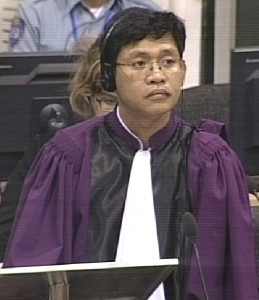
National Deputy Co-Prosecutor Seng Leang
National Deputy Co-Prosecutor Seng Leang started his line of questioning by inquiring whether he was village chief of Prah Keab in 1971. Mr. Leang wanted to know whether it was under the control of the Liberation Force or of the Khmer Rouge. He answered that the Khmer Rouge controlled the area. He was appointed village chief by the commune. He was unsure whether Vietnamese people lived in his village. There was a time that Vietnamese people were rounded up.
Mr. Leang asked whether it was a Khmer Rouge policy to round up the Vietnamese and whether it happened in 1975. The witness confirmed this. He became a messenger for the district. With this, the Deputy Co-Prosecutor finished his line of questioning.
The President gave the floor to Judge Jean-Marc Lavergne. He wanted to know whether the person called Phy had “particular physical features”, and in particular whether he limped. The witness confirmed this. As for the transportation of the people, he denied that they were tied or handcuffed. Judge Lavergne said that he understood that there had been lists of people and whether Mr. Lorn received some himself.
At this point, Ms. Guissé interjected. She said that she was unable to object, but that she did not understand where the “list” came from. Judge Lavergne said that he was referring to the same documents that the Co-Prosecutor referred to. The witness did not receive any list. “There were other individuals who were responsible for that.”
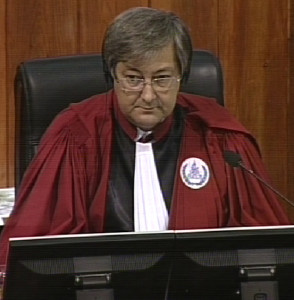
Judge Jean-Marc Lavergne
He could not recall whether there were any. He did not see the commune militia in the communes, he only saw the commune chiefs when he came to collect the people. He recounted that they were told that they were being sent back to their home country Vietnam. They had their own personal belongings, such as clothes and cooking utensils, with them. He could not hear them speaking. He did not witness any incident of resistance. He did not see any other trucks. He did not know where they went to afterwards.
The President gave the floor to Khieu Samphan Defense Counsel Ms. Guissé.
Ta Mok and Pech Chim
After the break, Ms. Guissé asked about his level of education. He replied that he went to primary school first, and then went to study at a school near Ang Ta Saom. He attended school until he was 20 years old.
Ms. Guissé asked when Ta Mok married his elder sister. Ta Mok married his wife prior to the year when the Khmer Rouge took power. He became a messenger prior to the fall of Phnom Penh. He did not know Chim’s previous function before he took over Khom’s position. He saw him when Chim attended meetings where the commune chiefs were called. Chim did not assign him any tasks, since Mr. Lorn was a messenger. He denied that he received any task by Chim, even as a messenger. Chim came to the district office before the fall of Phnom Penh. He remained there in the capacity of the district secretary.
Ms. Guissé asked whether the name Chay meant anything to him, which he confirmed. Ta Chay worked at the commune in Thym Nha Trat while Mr. Lorn worked at the district office.
Ms. Guissé referred to Pech Chim’s testimony and asked whether Mr. Lorn remembered how long he was district chief in Tram Kok.[16] He replied that he did not have “the full picture.” He was not sure whether Chim was still district chief when he left to Battambang.
Ms. Guissé said that Pech Chim had said that he left his job in Tram Kok in February 1976. She asked whether this rang a bell. He answered that he did not know. When Ms. Guissé pressed on, he said he could not remember.
When Ms. Guissé asked what Mr. Lorn’s alias was, he said that his alias was Mouy.
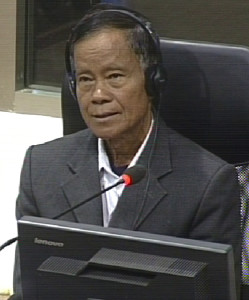
Witness San Lorn
Ms. Guissé turned to the number of people he had transported. She asked whether it was plausible based on the figures that he had provided that he was able to transport 9,000 people in a period of four days. He replied that he did not know. “The number of people was at hands of communes”.
Deportation of people
Ms. Guissé asked whether he picked up people in the morning in one commune and other people in other communes in the afternoon. He confirmed that this was correct. He confirmed that he went to more than two communes in one day. He also confirmed that he had only one truck. However, there was one other person who went along with him. “He was the one who actually maintained the car and who lent me his hands.” She then asked how far his home was from the place where he dropped people off. He answered that the distance was around ten kilometers.
She then turned to the meetings between Ta Mok and district officials and asked whether he agreed that he never attended such meetings, which he confirmed. Nor did he attend meetings with Pech Chim: “my presence was not required.”
She asked whether he ever attended meetings as his village chief. He said that he attended meetings with the commune on a frequent basis while being village chief. Someone replaced him when he became messenger. She asked whether it was therefore correct that he never attended meetings at the commune, district or village while being a messenger, which he confirmed.
When Ms. Guissé asked about the treatment of former Lon Nol officials, he said that he did not know about this issue. She asked whether he recalled the armed conflict between the Lon Nol soldiers and the Khmer Rouge. He said that he did not know about this.
Instructions by Ta Mok
She then wanted to know whether he knew the content of the letters of the district that Tuch brought, which he denied. She wanted to know how he knew that it were letters from Ta Mok if he did not know the content of the letters. He said that it had to be letters from Ta Mok. She then asked how he could know the role of the persons in meetings if he did not attend the meetings. He answered that he “had not idea” about the roles and positions of leaders, since he never attended meetings. Ms. Guissé asked whether he remembered the person Ek or Un Hoeun and that he told him that he had transported 9,000 people. He answered that he was not sure about this and did not know whether he had talked about it with this person. The same person had given names of the superiors of Mr. Lorn and had said that he received instructions from Ta Chay. He said that Phy issued the orders to him.
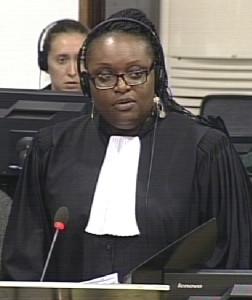
International Khieu Samphan Defense Counsel Anta Guissé
Ms. Guissé then wanted to know who conducted the training session. He said that the purpose of the training session was how to work the field and how to breed the rice. Ms. Guissé asked whether the Khmer Rouge arrived long after 17 April 1975 or shortly before the fall of Phnom Pen. He confirmed that he never had any transportation duties except this one time. He did not know the people on the trucks that he transported. She asked whether he had a particular reason why he said that he did not see them again if he did not know them. He answered that he had to move far away from them in the district an did not know about their whereabouts.
Ms. Guissé asked whether he had answered the questions to the best of his recollection or whether he had been hiding anything. He said that he had said the truth. With this, Ms. Guissé finished her line of questioning.
The President thanked the witness and dismissed him. The hearing will continue Monday, February 01 2016, at 9 am with the testimony of 2-TCW-889. Witness 2-TCW-1008 will be on the reserve.
[1] E3/9487, at answer 121.
[2] E1/298.1, testimony of Ul Hoeun, 07 May 2015, at 15:13.
[3] E3/20, p. 125, 00237830 (EN) 00638397 (FR), 00232166 (KH).
[4] Mr. E3/9487, at answers 673-673 and 926-929.
[5] E3/9487, at answer 676, and 678.
[6] E3/9487, answer 497-498.
[7] Ibid., answers 466-467
[8] Ibid., answers 907-911
[9] E3/9487, at answers 863-865.
[10] Ibid., at answer 445.
[11] E3/2435.
[12] E3/2049, E3/4082 (Ang Ta Saom); E3/2262 (Purpol); E3/2438 (Kus); E3/4083 (Srey Ronong).
[13] E3/9582, at answer113.
[14] E3/9594, at answer 12.
[15] E3/2048, 00079089 and 00079091 (KH), 00276562-63 and 00276564 (EN), 00611659 and 00611661 (FR).
[16] E1/292.1 Testimony of Pech Chim, at 10:08.
Featured Image: Witness San Lorn (Courtesy by ECCC: Flickr)
